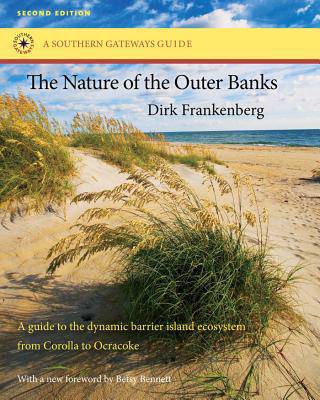
- Afhalen na 1 uur in een winkel met voorraad
- Gratis thuislevering in België vanaf € 30
- Ruim aanbod met 7 miljoen producten
- Afhalen na 1 uur in een winkel met voorraad
- Gratis thuislevering in België vanaf € 30
- Ruim aanbod met 7 miljoen producten
Zoeken
The Nature of the Outer Banks
Environmental Processes, Field Sites, and Development Issues, Corolla to Ocracoke
Dirk Frankenberg
€ 29,45
+ 58 punten
Omschrijving
North Carolina's Outer Banks are in constant motion, responding to weather, waves, and the rising sea level. Beaches erode, sometimes taking homes or sections of highway with them into the surf; sand dunes migrate with the wind; and storms open new inlets and dump sand in channels and sounds. A classic guide, The Nature of the Outer Banks describes these dynamic forces and guides visitors to sites where they can see these phenomena in action.
In the first section of the book, Dirk Frankenberg highlights three major processes on the Outer Banks: the rising sea level, movement of sand by wind and water, and stabilization of sand by plant life. In the second section, he provides a mile-by-mile field guide to the northern Banks, and in the final section, he alerts readers to the dangers of overdevelopment on the Outer Banks. In a new foreword for this edition, Betsy Bennett documents the ever-more-critical situation of these shifting sands.
Southern Gateways Guide is a registered trademark of the University of North Carolina Press
In the first section of the book, Dirk Frankenberg highlights three major processes on the Outer Banks: the rising sea level, movement of sand by wind and water, and stabilization of sand by plant life. In the second section, he provides a mile-by-mile field guide to the northern Banks, and in the final section, he alerts readers to the dangers of overdevelopment on the Outer Banks. In a new foreword for this edition, Betsy Bennett documents the ever-more-critical situation of these shifting sands.
Southern Gateways Guide is a registered trademark of the University of North Carolina Press
Specificaties
Betrokkenen
- Auteur(s):
- Uitgeverij:
Inhoud
- Aantal bladzijden:
- 176
- Taal:
- Engels
- Reeks:
Eigenschappen
- Productcode (EAN):
- 9780807872345
- Verschijningsdatum:
- 12/03/2012
- Uitvoering:
- Paperback
- Formaat:
- Trade paperback (VS)
- Afmetingen:
- 152 mm x 188 mm
- Gewicht:
- 204 g

Alleen bij Standaard Boekhandel
+ 58 punten op je klantenkaart van Standaard Boekhandel
Beoordelingen
We publiceren alleen reviews die voldoen aan de voorwaarden voor reviews. Bekijk onze voorwaarden voor reviews.











